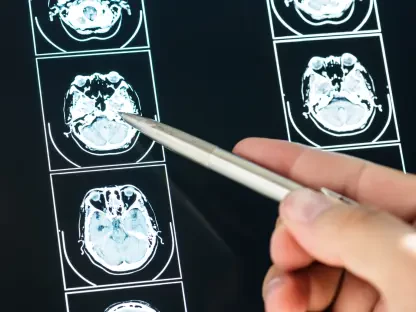Imagine a world where cancer treatment is as unique as a fingerprint, tailored precisely to the molecular makeup of an individual’s tumor with minimal harm to surrounding healthy tissues, a vision that is no longer a distant dream but a tangible reality thanks to theranostics. This innovative approach in nuclear medicine seamlessly blends diagnostic imaging and targeted therapy. By employing radiolabeled compounds, theranostics allows clinicians to visualize cancer at a molecular level and deliver pinpoint radiation treatments, transforming the landscape of precision oncology. This groundbreaking strategy not only enhances the accuracy of cancer detection but also ensures therapies are customized to each patient’s specific needs, marking a significant departure from traditional, often less discriminating methods. As this field continues to evolve, it holds the promise of redefining cancer care by prioritizing personalization and effectiveness, setting a new standard for how malignancies are managed in modern medicine.
Unlocking Personalized Cancer Treatment
Theranostics stands out for its remarkable ability to customize cancer care in ways previously unimaginable. At its heart, this approach uses specially engineered molecules, such as peptides or antibodies, to target specific markers on cancer cells. These molecules are paired with radionuclides that serve dual purposes: some emit signals for diagnostic imaging to map out tumor characteristics, while others deliver therapeutic radiation directly to the cancer site. This integration means that treatment plans can be adapted based on real-time insights into how a tumor behaves, offering a level of precision that broad-spectrum therapies often lack. The result is a strategy that not only identifies the presence of cancer with exceptional detail but also attacks it with focused intent, minimizing collateral damage to healthy tissues and improving patient outcomes in a profoundly individualized manner.
Beyond the mechanics of targeting, the personalization offered by theranostics extends to monitoring and adjusting treatments as needed. Molecular imaging provides a window into the tumor’s response during therapy, allowing clinicians to tweak dosages or switch approaches if the cancer shows signs of resistance or change. This dynamic adaptability sets theranostics apart from conventional methods, where feedback on treatment efficacy might take weeks or months to emerge through anatomical imaging alone. The ability to make informed decisions swiftly ensures that patients receive the most effective care at every stage of their journey. Moreover, this approach is gaining traction across various cancer types, from neuroendocrine tumors to prostate cancer, demonstrating its versatility and reinforcing the shift toward tailored medical interventions that prioritize the unique biological profile of each patient’s disease.
Integrating Theranostics with Modern Therapies
The potential of theranostics is amplified when combined with other advanced treatment modalities, creating a synergistic effect in oncology. One promising avenue is the pairing of radioligand therapy with immunotherapies, such as immune checkpoint inhibitors. This combination aims to harness radiation-induced cell death to stimulate the body’s immune system, potentially breaking through barriers of resistance that can hinder standalone treatments. By integrating these therapies, there’s an opportunity to enhance the body’s natural defenses against cancer while targeting tumors with precision. Clinical trials exploring these partnerships are underway, signaling a growing recognition of theranostics as a vital component within a broader, more comprehensive cancer treatment framework that could redefine therapeutic success.
Technological progress further bolsters the integration of theranostics into mainstream oncology. Cutting-edge imaging systems like PET/CT and PET/MRI provide unprecedented clarity in visualizing tumors, allowing for better staging and treatment planning. Simultaneously, advancements in radiopharmaceutical design are improving the specificity and effectiveness of these agents, ensuring higher tumor-to-background ratios for optimal results. The emergence of artificial intelligence and machine learning adds another layer of sophistication by automating complex image analysis and predicting the most effective treatment strategies. These technological strides not only enhance the precision of theranostics but also pave the way for its seamless incorporation alongside other innovative therapies, positioning it as a cornerstone of future cancer care protocols that prioritize both accuracy and adaptability.
Navigating Safety and Accessibility Barriers
While the benefits of theranostics are undeniable, ensuring patient safety remains a critical focus of ongoing research and development. The use of radiation, even when targeted, carries risks such as potential damage to healthy tissues like bone marrow, salivary glands, or kidneys, especially in areas where target antigens are expressed or radiopharmaceuticals are cleared. To address these concerns, studies are exploring protective agents and refined dosing schedules to minimize toxicity. Continuous post-therapy monitoring is also being emphasized to catch and manage any adverse effects early. These efforts highlight a commitment to balancing the powerful therapeutic capabilities of theranostics with the imperative to safeguard patient well-being, ensuring that this approach remains a viable and trusted option for cancer management.
Accessibility and economic factors present additional challenges that must be tackled for theranostics to reach its full potential. The production of specialized radionuclides and radiopharmaceuticals demands sophisticated infrastructure and adherence to stringent regulatory standards, which can restrict availability, particularly in under-resourced regions. However, the long-term cost-effectiveness of this approach—by reducing the need for ineffective treatments and cutting down on hospital stays—makes a strong case for increased investment. Expanding education among healthcare providers and fostering multidisciplinary collaboration between oncologists, nuclear medicine experts, and other specialists are essential steps toward integrating theranostics into routine clinical practice. Overcoming these logistical hurdles will be key to ensuring that the transformative benefits of this technology are accessible to a broader population of cancer patients.
Future Horizons in Precision Oncology
Looking ahead, the trajectory of theranostics points to an exciting evolution in cancer care driven by relentless innovation. The integration of artificial intelligence and machine learning is poised to revolutionize diagnostic accuracy and therapeutic precision, offering predictive models that could identify novel radiotracers or optimal treatment combinations. The vision of a closed-loop system, where therapies continuously adapt based on real-time molecular imaging feedback, represents a future where cancer management is as dynamic as the disease itself. Such advancements suggest that theranostics could soon become a foundational element in oncology, pushing the boundaries of what personalized medicine can achieve and offering hope for improved survival rates across diverse cancer types.
Reflecting on the strides made, it’s evident that theranostics has already reshaped the approach to precision oncology with remarkable success. The journey witnessed over recent years showcased how this dual diagnostic-therapeutic strategy honed in on tumor-specific markers, delivering tailored interventions that prioritized both efficacy and safety. Challenges in safety protocols and accessibility were met with innovative solutions and collaborative efforts, while technological integrations amplified its impact. As the field matured, it laid a robust groundwork for future explorations. Moving forward, the focus should shift toward scaling access through strategic investments and global partnerships, ensuring that the benefits of theranostics reach every corner of cancer care while continuing to refine its precision through emerging technologies.









